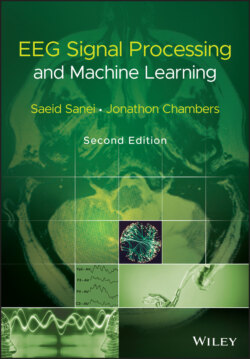Читать книгу EEG Signal Processing and Machine Learning - Saeid Sanei - Страница 50
3.4.3 Gaussian Mixture Model
ОглавлениеIn this very popular modelling approach the signals are characterized using the parameters of their distributions. The distributions in terms of probability density functions are sum of a number of Gaussian functions with different variances which are weighted and delayed differently [48]. The overall distribution subject to a set of K Gaussian components is defined as:
(3.57)
The vector of unknown parameters θk = [wk , μk , σk ] for k = 1,2, …, K. wk is equivalent to the probability (weighting) that the data sample is generated by the kth mixture component density subject to:
(3.58)
μk , and σk are mean and variances of the kth Gaussian distribution and p(x| μk , σk ) is a Gaussian function of x with parameters μk , and σk . Expectation maximization (EM) [49] is often used to estimate the above parameters by maximizing the log‐likelihood of the mixture of Gaussian (MOG) for an N‐sample data defined as:
(3.59)
The EM algorithm alternates between updating the posterior probabilities used for generating each data sample by the kth mixture component (in a so‐called E‐step) as:
(3.60)
and weighted maximum likelihood updates of the parameters of each mixture component (in a so‐called M‐step) as:
(3.61)
(3.62)
(3.63)
The EM algorithm (especially in cases of high‐dimensional multivariate Gaussian mixtures) may converge to spurious solutions when there are singularities in the log‐likelihood function due to small sample sizes, outliers, repeated data points or rank deficiencies leading to ‘variance collapse’. Some solutions to these shortcomings have been provided by many researchers such as those in [50–52]. Figure 3.13 demonstrates how an unknown multimodal distribution can be estimated using weighted sum of Gaussians with different mean and variances:
Figure 3.13 Mixture of Gaussian (dotted curves) models of a multimodal unknown distribution (bold curve).
Similar to prediction‐based models, the model order can be estimated using Akaike information criterion (AIC) or by iteratively minimizing the error for best model order. Also, mixture of exponential distributions can also be used instead of MOGs where there are sharp transients within the data. In [53] it has been shown that these models can be used for modelling variety of physiological data such as EEG, EOG, EMG, and ECG. In another work [54], the MOG model has been used for segmentation of magnetic resonance brain images. As a variant of the Gaussian mixture model (GMM), Bayesian GMMs have been used for partial amplitude synchronization detection in brain EEG signals [55]. This work introduces a method to detect subsets of synchronized channels that do not consider any baseline information. It is based on a Bayesian GMM applied at each location of a time–frequency map of the EEGs.
